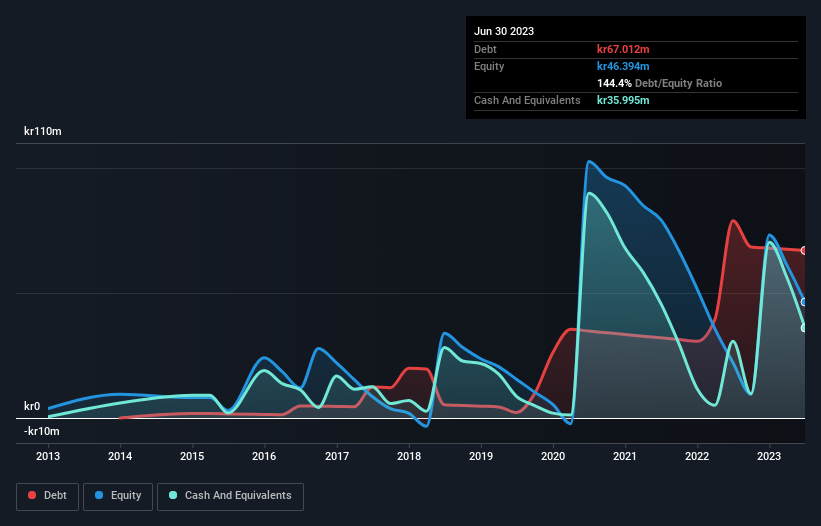
Warren Buffett famously said, 'Volatility is far from synonymous with risk.' It's only natural to consider a company's balance sheet when you examine how risky it is, since debt is often involved when a business collapses. We can see that Nanologica AB (publ) (STO:NICA) does use debt in its business. But the more important question is: how much risk is that debt creating?
What Risk Does Debt Bring?
Debt assists a business until the business has trouble paying it off, either with new capital or with free cash flow. Part and parcel of capitalism is the process of 'creative destruction' where failed businesses are mercilessly liquidated by their bankers. However, a more usual (but still expensive) situation is where a company must dilute shareholders at a cheap share price simply to get debt under control. By replacing dilution, though, debt can be an extremely good tool for businesses that need capital to invest in growth at high rates of return. When we think about a company's use of debt, we first look at cash and debt together.
View our latest analysis for Nanologica
What Is Nanologica's Debt?
You can click the graphic below for the historical numbers, but it shows that Nanologica had kr67.0m of debt in June 2023, down from kr78.9m, one year before. On the flip side, it has kr36.0m in cash leading to net debt of about kr31.0m.

How Healthy Is Nanologica's Balance Sheet?
We can see from the most recent balance sheet that Nanologica had liabilities of kr10.3m falling due within a year, and liabilities of kr67.7m due beyond that. Offsetting this, it had kr36.0m in cash and kr909.0k in receivables that were due within 12 months. So its liabilities outweigh the sum of its cash and (near-term) receivables by kr41.1m.
Given Nanologica has a market capitalization of kr315.9m, it's hard to believe these liabilities pose much threat. However, we do think it is worth keeping an eye on its balance sheet strength, as it may change over time. When analysing debt levels, the balance sheet is the obvious place to start. But ultimately the future profitability of the business will decide if Nanologica can strengthen its balance sheet over time. So if you're focused on the future you can check out this free report showing analyst profit forecasts.
In the last year Nanologica wasn't profitable at an EBIT level, but managed to grow its revenue by 27%, to kr7.2m. With any luck the company will be able to grow its way to profitability.
Caveat Emptor
While we can certainly appreciate Nanologica's revenue growth, its earnings before interest and tax (EBIT) loss is not ideal. Indeed, it lost a very considerable kr46m at the EBIT level. Considering that alongside the liabilities mentioned above does not give us much confidence that company should be using so much debt. So we think its balance sheet is a little strained, though not beyond repair. Another cause for caution is that is bled kr57m in negative free cash flow over the last twelve months. So suffice it to say we consider the stock very risky. The balance sheet is clearly the area to focus on when you are analysing debt. However, not all investment risk resides within the balance sheet - far from it. These risks can be hard to spot. Every company has them, and we've spotted 5 warning signs for Nanologica (of which 1 is a bit unpleasant!) you should know about.
If, after all that, you're more interested in a fast growing company with a rock-solid balance sheet, then check out our list of net cash growth stocks without delay.
Valuation is complex, but we're here to simplify it.
Discover if Nanologica might be undervalued or overvalued with our detailed analysis, featuring fair value estimates, potential risks, dividends, insider trades, and its financial condition.
Access Free AnalysisHave feedback on this article? Concerned about the content? Get in touch with us directly. Alternatively, email editorial-team (at) simplywallst.com.
This article by Simply Wall St is general in nature. We provide commentary based on historical data and analyst forecasts only using an unbiased methodology and our articles are not intended to be financial advice. It does not constitute a recommendation to buy or sell any stock, and does not take account of your objectives, or your financial situation. We aim to bring you long-term focused analysis driven by fundamental data. Note that our analysis may not factor in the latest price-sensitive company announcements or qualitative material. Simply Wall St has no position in any stocks mentioned.
About OM:NICA
Nanologica
A nanotechnology company, develops, manufactures, and sells nanoporous silica particles for life science industry in China, India, the United State of America, and internationally.
Medium-low with adequate balance sheet.
Similar Companies
Market Insights
Community Narratives



